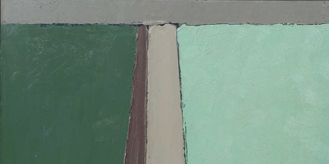
At the end of the 1970’s, thanks once more to his friend Paolo Mangini, Congdon left his house in Assisi and found a new place in Gudo Gambaredo, in the countryside outside Milan, in the annex to a Benedictine monastery, known as Cascinazza. Congdon seemed to sink into a land that was like “a filthy wet sponge”: Venice had never felt so far away. It was like being swallowed by a ‘hell’ land, a black hole that seemed to suck out all the Beauty he had previously contemplated.
«In 1979 I was taken to a place without a character, without memory: the Bassa Milanese. It was exactly like when I began painting in New York after the war in 1948, without memory, without tradition, naked and poor.»
Absorbed in the contemplation of the silent dialogue between sky and earth, Congdon gradually discovered a deep analogy between the work of a painter and that of a peasant: patient, humble, subject to the rhythm of the seasons. The contemplative disposition of these years and the reconciliation that can be seen in his new paintings did not mean that there were no periods of creative ‘sterility’ and times of great restlessness. Congdon remained anchored to his ‘farmhouse boat’ run aground in the Bassa countryside not just because of his obvious physical limitations, but also thanks to the affectionate and inconspicuous proximity of the Benedictine monks of Cascinazza.
«Among all the buildings the Monastery is the ship. In the fog, without lights, the Cascinazza building - with its cargo of prayers for those sleeping and those waking alike - sails (…) the waters of the earth, of life.»
In 1982 Congdon went through another period of creative inactivity: escape tempted him again. Also the Milanese countryside, like many other places in the past, now seemed to have exhausted itself. Congdon felt as if he had gone back to his starting point, a place of darkness and blindness, of which the Lombardy fog was the perfect physical expression. Once again, the stifling unpleasant fog was not the final word. It could transform itself into an opening, into unexpected possibilities.
«The Subject is fog, dressed not in what it has buried, but in what it has revealed, - chosen fragments of redemption, to give a name to nothingness (…).»
The apparent stop to his endless travels opens new and unexpected horizons.
«I had to be reborn into a new life, my final life, as a result of which all my past lives were forgiven. I did not achieve Forgiveness in Venice. So where did God want to place me for this forgiveness (…) to help renew my painting that, like life, had to encompass all the past? Certainly this maturation could not happen in a place of my choosing, the way I had chosen all the other places of my past (…). So it had to happen in a ‘neutral’ place, or better, a hostile place; a place so distant from my natural temperament that it could be considered the representation of the pain of my personal exile from all that had supported, comforted, satisfied and inspired me throughout my life: all in all an exile!
For this reason when I arrived in Gudo (…), I called it ‘the shit-hole of the world’. Everyone remembers this expression of mine. However, yes it is a shit-hole, but it was the greatest grace that God had given me.
Once it was different because I traveled in order to paint. Now I don’t. Therefore the terms seem to have been reversed: if in the past the journey led to painting, now it is painting that, from within, gives rise to the ‘journey’.»